>>Basic Data of Japan ![]() >>Basic Data of China
>>Basic Data of China ![]() >>Basic Data of USA
>>Basic Data of USA ![]()
In contemporary societies preschools are sites for the socialization and enculturation of young children. Preschools are not just places where children develop physically, emotionally, and intellectually but also where they learn to be appropriate members of their culture. Preschools are where young Japanese children become Japanese, young Chinese children become Chinese, and young American children become American. In other words, preschools are key sites for the continuation and transmission of culture. These were the main findings of Preschool in Three Cultures: Japan, China, and the United States (Psin3C), a book published in 1989 by Joseph Tobin, David Wu, and Dana Davidson.
Preschools are sites not just of cultural continuity but also of change. Preschools must deal with such changes as declining birth rates, urbanization, women's work patterns, and the development of new technologies. Preschools are asked to prepare children who will both be familiar and appropriate members of their culture and at the same time who grow up to be successful in the new forms of society that await them. These were the key themes of the book Preschool in Three Cultures Revisited, published in 2009 by Joseph Tobin, Yeh Hsueh, and Mayumi Karasawa. This book added to the first book's emphasis on culture and historical dimension, as it explored the question of how and why national systems of early childhood education both stay the same and change over time.
Both of these studies suggested that in a world that many people perceive to be too rapidly changing, preschools are looked to as key sites for preserving core cultural beliefs. But preschools are also cultural in another sense: they are sites that reflect cultural beliefs and practices about early childhood education and care. Although there is wide variation in each country, the Psin3C studies showed that in each culture there are commonly shared beliefs and practices of teachers, beliefs and practices, for example, that are shared by most Japanese teachers that make them different from their Chinese and American counterparts. We suggest that this widespread sharing within a nation of approaches to teaching is in large part due to "implicit cultural beliefs and practices," implicit because for the most part these beliefs and practices are not directly taught or learned in schools of education, written down in textbooks, or mandated in policy documents. Instead, they reflect an implicit cultural logic, and are passed down through on the job learning from older to newer teachers and less directly through the reproduction of the larger cultures in which preschools are located.
In these papers we describe the unique method that is used in these studies; present key findings from both the original study and the sequel; and conclude with some examples of how we are extending this research into a new direction including studies of kindergartens in schools for the deaf.
Video-cued Multivocal Ethnography
Both the old and new Psin3C studies employed the same research method, "video-cued multivocal ethnographic method." In this method we make videos of typical days in preschools in each country in the study. But the videos are not the primary data of the study. Instead, the videos are used as rich, nonverbal interviewing cues to stimulate reaction and reflection from teachers, administrators, and early childhood education experts. It is what these stakeholders say about the videos, rather than the videos themselves, that form the key findings of our studies.
The Psin3C books feature the perspectives of Japanese, Chinese, and American preschool teachers and directors explaining the thinking behind the practices seen in the videos. These videos as well as the products become the products of the research. These videos are widely used in the US in university courses for pre-service and in-service teachers as well as in courses in anthropology, cross-cultural psychology, and sociology.
Key Findings from These Studies
1. China: The Storytelling King;
Our research in preschools across China clearly showed that preschools have been drawing heavily in recent years on ideas from abroad. And yet, the new approaches to early childhood education that are emerging in progressive Chinese preschools retain a characteristically Chinese inflection, as we can see in a scene in our video we call "Story Teller King," a video we shot at Sinan Road Kindergarten in Shanghai, a kindergarten that is well known as a leader in China's progressive educational reform.
In the video we see the whole class gathered on the rug and one boy, Ziyu, standing in front of them to tell a story.
Here's the gist of Ziyu's story: "In a forest lived many animals. One day an owl heard a strange noise in the pond, 'Goodong,' that scared him. He went to tell others. Those who went to check thought that there was a monster in the pond. In the end, a lion went to the pond to check only to find a ripe papaya falling from the tree to make the noise. Everyone was relieved."
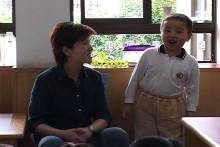 1. story begins |
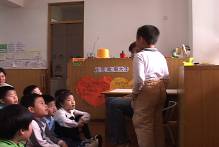 2. telling the story |
Ziyu finished the story, said "thank you," and took a seat on the floor with his classmates. Ms. Wang, one of the two teachers, asked the children what they had heard in the story. Some children said that there was an owl and the teacher asked what the owl was doing before it heard the noise. This exchange went on for a few turns before Ms. Wang asked the group whether Ziyu could be named Story King. Some said "yes" and some said "no." The children then voted.
Ziyu was invited to count the votes. He won the honor by a majority, with 18 of 24 children voting "yes." He then wrote his name on the red Story King poster. Then Ms. Wang said, "Some children didn't raise their hands. Shall we listen to their arguments? A few children remarked, "He was not loud enough." "He did not say things clearly sometimes."
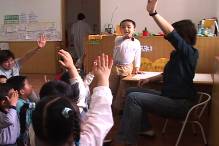 3. counting the votes |
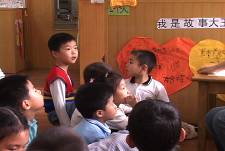 4. receiving critiques |
And the teacher turned to Ziyu and asked if he agreed. In the end, he was invited to select a story person for the next day. He chose a girl who commented critically earlier that his story sounded like the one they had heard on a recording.
Ms. Cheng and Ms. Wang, the two teachers in the video, explained how the Story King activity gets started:
"In the beginning, children just wanted to listen to a story that the teacher would tell," Ms. Cheng recalled. "Later, a couple of children who were interested in telling stories asked if they could come to the front to tell a story. We encouraged them to give it a try. Soon, many children began to prepare their own stories and asked for their turns." Ms. Wang continued, "After the first semester, when so many children wanted to tell a story in front of the group, they got into a discussion among themselves about how to organize the event. They reached agreement that whoever was the story person of the day could choose the story person for the next day."
The Story Telling King activity is a perfect example of the emerging hybridity of Chinese educational practice (Zhu & Zhang 2008, 176), as it combines progressive beliefs in child-initiated curricula, a Deweyian notion of the democratic classroom, self-expression, and content-area integration with Chinese traditions of verbal performance and mastery and a belief that is both traditional and Chinese socialist in the pedagogical value of constructive criticism.
Straightforward criticism has long been a common feature of Chinese daily life, not only in the first thirty years of the People's Republic, when the Cultural Revolution and other social movements required people to be self-critical as well as critical of others, but also in the pre-revolutionary periods, when Confucianism encouraged criticism as a means towards cultivating learning and promoting social values. Constructive feedback from both experts and peers can be found in Chinese education not just in the early childhood classroom, but also in the preparation and ongoing professional development of teachers, in reciprocal critique and discussion sessions called qiecuo (learning from each other by exchanging ideas). In both activities we find a belief not just in the value of constructively giving and humbly accepting critical feedback but also in the value of oral performance, "virtuosity," and of learning as a process of "self-perfection."
Both the critical feedback and the pursuit of virtuosity seen in this story telling activity are examples of what we are calling "culturally implicit practices," in that although these practices are not encouraged or even mentioned in the new curriculum guidelines, they are common features of contemporary Chinese early childhood educational practice that survive from one social upheaval and pedagogical paradigm shift to the next and which Chinese teachers feel no need to explain, justify, or reflect on until they are prompted to do by outsiders.
As we did our research in China from 2002-2007, we arrived at a preliminary thesis: China early childhood education was moving inexorably down a path from more didactic, teacher-directed, knowledge transmission pedagogy towards constructivist, child-initiated and child-directed pedagogy. However, a final round of interviews we conducted in 2007 with Chinese early childhood educators led us to change our thesis, and to tell a more complicated story. Our new conclusion was that the aggressive push toward progressivism and child-centeredness that characterized Chinese early childhood education from about 1990 to 2006 has begun to be counterbalanced by an acknowledgment of the value of traditional Chinese pedagogical practices, including the value of direct instruction and the mastery of skills. The period of intense borrowing is being replaced by a period of consolidation and hybridization of foreign and domestic educational ideas.
2. US: Choice
Now, as in the 1980s, choice remains a key feature of the curriculum and pedagogy of American preschools. When children arrive at most American preschools they are asked by the teachers, "What would you like to do?" The choices are not unconstrained. "What would you like to do?" is followed up by a menu of alternatives: "Would you like to help Alex with his puzzle? Read a book? Draw? Help feed the turtle?" We can see how choices are presented in a scene from St. Timothy's Child Center in Hawaii.
 Fran and Precious |
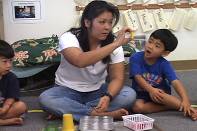 Jannie with choice tray |
There are multiple times of the day at St. Timothy's and Alhambra when the teachers announce that it is time to make choices and draw attention to the task: "You're song helper today. Do you know what song you want to choose? Do you need to think about it for a minute? Do you want some suggestions from your friends?" "What center do you want to go to? Don't just point. Say it with words. Blocks? Good choice."
Why the emphasis on choice in US early childhood education? There is no single answer. Choice is wrapped up with the American cultural belief that young children (along with the rest of Americans) have an inalienable right to the pursuit of happiness and fun, and activities that are individually chosen are assumed to be inherently more pleasurable than those that are collectively chosen or assigned. The belief that preschool should be fun and full of choice is in tension these days with growing pressure on young children to learn to read. But even the most zealous advocates of pushing an academic curriculum down into the preschool years take care to present this curriculum as fun and to offer children choices within structured and even scripted lessons.
Choice is also valued because it is believed to foster intrinsic motivation and thereby to facilitate learning. In comments of American early childhood educators about the US videos, we can deduce an underlying cultural or folk theory of learning that links choice to intrinsic motivation and to constructivist pedagogy: learning centers are important for children of this age because children can choose activities within their zone of proximal development; children learn best when they choose the activity; if you choose for them, they resist, they are less engaged, and they learn less.
Choice is also tied up with notions of democracy. Letting children choose between building with Legos and playing at the water table is seen as providing practice in exercising the rights of democratic citizenship and more generally, of "independent decision making" (Lee & Walsh 2005, 63). While most American educators who watched and commented on the Alhambra video were critical of the Pledge of Allegiance as an age-inappropriate display of patriotism that teaches young children no valuable lessons about democracy or citizenship, there was widespread support for the notion that choice and child-initiated activities support democratic values. As a preschool director in Phoenix told us after watching the St. Timothy's video:
"I like the way this teacher lays out the options for learning centers and then patiently gives each child the chance to choose a preferred activity. I am really into Alfie Kohn [1996]. You can't teach democratic values by lecturing about them. You have to organize your classroom as a democracy and let children experience what it feels like to be in a democratic environment where their individual voices and choices matter."
3. Japan: Teachers Approaches to Dealing with Children's Fights
In the original study, a key scene in our video of a Day at Komatsudani Preschool, in Kyoto, shows a four-year-old boy, Hiroki, steps on one boy's hand, making him cry while his teacher, Fukui-sensei, who is nearby, appears to do nothing. In the video we made at Komatsudani twenty years later, there is another fight, this time between a group of girls who squabble over a teddy-bear, eventually falling into a pile on the floor pulling and tugging on the bear and then having an extended argument about whose turn it was to have the bear. In this scene, as in the one twenty years earlier, the teacher (Morita-sensei) is nearby, but she does nothing more to stop the fighting that to call out to the girls, "Kora Kora" ("Hey there").
When we interviewed Fukui-sensei in 1985 and Morita-sensei twenty years later, they gave similar explanations for their non-intervention. Both emphasized that by holding back from intervening they are giving children the opportunity to experience social interaction and to learn to solve their own problems. In the second book we described this non-intervention approach using the Japanese terms machi no hoiku (supporting child development through waiting) mimamoru (watching and waiting) and suggested that the Komatsudani teachers' non-intervention in children's fights is an example of a characteristically Japanese approach to classroom management, an example of an implicit cultural belief and practice that is not taught in schools of education and yet which is familiar to most Japanese early childhood teachers.
Many readers of the first book misunderstood our central point to be that Japanese teacher rarely or never intervene in children's fights. But this is not the case. Instead, our argument is that non-intervention is an option that is more culturally available to Japanese teachers than to their American and Chinese counterparts and that Japanese teachers strategically choose to intervene or not intervene in order to foster children's social and emotional development.
In the second study we videotaped in two preschools in each country, preschools selected to represent different types of early childhood provision. The second preschool we videotaped in Japan is a yochien, Madoka Yochien in Tokyo. In the Madoka video there is also a fight, in which two boys have a brief tussle involving pinching and hair pulling. But in this case the teacher, Kaizuka-sensei, quickly intervenes. In the video we see Taichi, in tears, approach Kaizuka-sensei (Figure 1):
Taichi: Takashi pulled my hair.
Kaizuka: Why did you do that, Takashi?
Takashi: Cuz Taichi-kun pinched me. (Figure 2)
Kaizuka: You say he pinched you first? Is that true?
Takashi: No.
Kaizuka: That's strange. (Figure 3)
Taichi: He walked by and pulled my hair.
Kaizuka: And then you pinched him? Taichi, did you pinch him or not? You pinched him, right? I don't like this. God sees everything you do. (Figure 4). Do you understand? Think about it. And when you are ready to tell the truth, come talk to me. Think about it. I am more bothered by your lying than by what you did. Think about it. (as Kaizuka turns her attention momentarily to a girl asking for help with a button, Takashi wanders away). Takashi, come back, we're not done.
Takashi (with tears in his eyes, whimpering): I did it first. (Figure 5)
Kaizuka: It's really important to say you're sorry when you do bad things. I've done bad things to friends, but then I realized I was wrong, and apologized. If you apologize, you feel much better. Do you understand? Do you have something to say?
Takashi: I'm sorry.
Taichi: That's okay.
Kaizuka (to Taichi): You, also, have to say, "sorry"
Taichi: I'm sorry. (Figure 6).
Takashi: That's okay.
 Figure 1 |
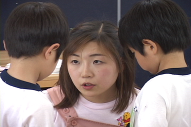 Figure 2 |
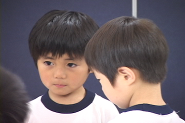 Figure 3 |
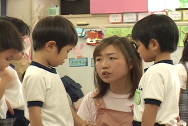 Figure 4 |
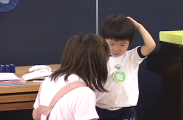 Figure 5 |
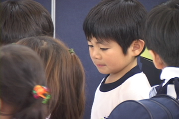 Figure 6 |
The analysis of this scene presented in Preschool in Three Cultures Revisited emphasizes that Kaizuka-sensei is intent on teaching these two boys the importance of being sincere and telling the truth. As Kaizuka-sensei explained:
"The boys eventually apologized to each other, but that was not my goal in intervening. With three-year-olds, who don't yet know how to apologize, I might lead them through a process of apologizing and accepting others' apologies, so they will not know how to do this on their own in the future. But these boys already know how to apologize, so if they don't apologize, it is because they aren't sorry for what they've done, so there is nothing to be gained by forcing them to apologize, if the feeling isn't there. I wanted them to understand the importance of being truthful and to think about the effects on others and on oneself of hair-pulling, hitting, and especially of lying. If, after thinking about the effects of their behaviors, they chose to apologize, that is fine, but it wasn't my goal."
The analysis of this scene in Preschool in Three Cultures Revisited focuses on Kaizuka's intervention as an example of a deeper cultural belief and practice of Japanese teachers to help young children experience and deal with emotion:
It's not just that she found his lying about hair-pulling to be more serious than other misbehaviors--it was, she explained when she watched the video, the lying, not the hair pulling, that bothered her most. We would also suggest that the goal of her intervention was not just to get the boys to tell the truth and then to apologize but also and perhaps even more importantly to get them to express and acknowledge sadness, an emotion that, as we discuss in the next section, is highly culturally valued. She felt so strongly that this was a valuable teaching opportunity that she invested more than five minutes dealing with the boys during the hectic changing time when many children were asking for her assistance with buttons and tight shirts (2009, 134-5).
Both Morita-sensei's seemingly laisser-faire approach and Kaizuka-sensei's seemingly overly aggressive one need to be understood as thoughtful, intentional strategies that follow cultural scripts that are well known, understood, and employed by other Japanese teachers, even if they aren't written in textbooks or articulated in curriculum guides. The artful, strategic deployment over time of both of these scripts is intended to produce children who are both self-reliant and interpersonally skilled, spontaneous, joyful, and emotionally responsive. As Morita-sensei explained:
"I think children can learn many things from fighting. For example, they can learn that if I say something hurtful to another person, it makes me sad. The person who does something and the person who has something done to her are always changing, right? One day, a girl might hit somebody and the next day she might be hit. During this process of switching positions, people come to understand feelings. People can't come to understand feelings without having direct experience."
Conclusion
Given the assumption that three- and four-year-old children around the world have similar abilities, needs and interests, one might expect preschools in different countries to be much the same. The major contribution of the original Preschool in Three Cultures was to make clear that Japanese, Chinese, and US preschools, circa 1984, were very different and that much of the difference could be attributed to culture. The central question of Preschool in Three Cultures Revisited is whether a generation later we would find in these three countries' preschools a persistence of these cultural differences or whether with increased globalization Japanese, Chinese, and US preschools would have become more alike and lost some of their cultural distinctiveness.
Since the mid-1980s have Chinese, Japanese, and US preschools become significantly more alike? Our answer, in a word, is "No." Our conclusion is that despite modernization and globalization, Chinese, Japanese, and American approaches to early childhood education are no more alike in their core practices and beliefs than they were a generation ago. Or rather we should say that over time they have become more alike in some ways and more different in others. Our study has shown that some cultural practices have been replaced by practices borrowed from abroad, but other cultural practices have emerged unscathed from their encounter with globally circulating ideas, still others have evolved into hybrid forms the way some new cultural practices have been invented.
If you are interested in more details about our research, please contact us: Joseph Tobin (joetobin@uga.edu) and Akiko Hayashi (akiko.hayashi.1@asu.edu). Information on Preschool in Three Cultures and other projects is also available online at joetobin.net.
References
Lee, Kyunghwa, and Walsh, Daniel
2005 Independence and community: Teaching Mid-western. Journal of Early Childhood Teacher Education, 26, 59-77.
Tobin, Joseph., Hsueh, Yeh., and Karasawa, Mayumi
2009 Preschool in Three Cultures Revisited: China, Japan, and the United States.
The University of Chicago Press.
Tobin, Joseph., Wu, David., and Davidson, Dana
1989 Preschool in Three Cultures: Japan, China, and the United States. New Haven, CT: Yale University Press.
Zhu, Jiaxiong, and Zhang, Jie.
2008 Contemporary trends and developments in early childhood education in China. Early Years, 28 (2), 173-182.














